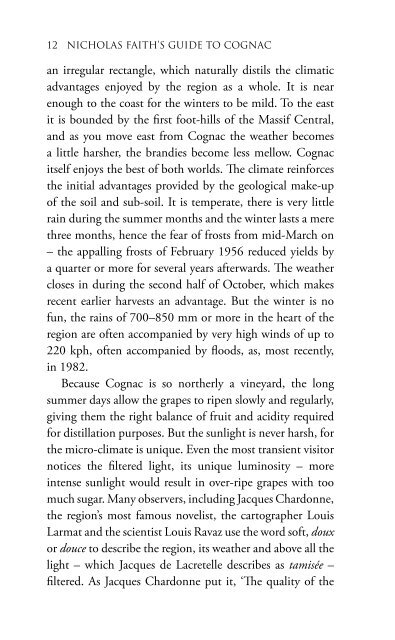You also want an ePaper? Increase the reach of your titles
YUMPU automatically turns print PDFs into web optimized ePapers that Google loves.
an irregular rectangle, which naturally distils the climatic<br />
advantages enjoyed by the region as a whole. It is near<br />
enough to the coast for the winters to be mild. To the east<br />
it is bounded by the first foot-hills of the Massif Central,<br />
and as you move east from <strong>Cognac</strong> the weather becomes<br />
a little harsher, the brandies become less mellow. <strong>Cognac</strong><br />
itself enjoys the best of both worlds. The climate reinforces<br />
the initial advantages provided by the geological make-up<br />
of the soil and sub-soil. It is temperate, there is very little<br />
rain during the summer months and the winter lasts a mere<br />
three months, hence the fear of frosts from mid-March on<br />
– the appalling frosts of February 1956 reduced yields by<br />
a quarter or more for several years afterwards. The weather<br />
closes in during the second half of October, which makes<br />
recent earlier harvests an advantage. But the winter is no<br />
fun, the rains of 700–850 mm or more in the heart of the<br />
region are often accompanied by very high winds of up to<br />
220 kph, often accompanied by floods, as, most recently,<br />
in 1982.<br />
Because <strong>Cognac</strong> is so northerly a vineyard, the long<br />
summer days allow the grapes to ripen slowly and regularly,<br />
giving them the right balance of fruit and acidity required<br />
for distillation purposes. But the sunlight is never harsh, for<br />
the micro-climate is unique. Even the most transient visitor<br />
notices the filtered light, its unique luminosity – more<br />
intense sunlight would result in over-ripe grapes with too<br />
much sugar. Many observers, including Jacques Chardonne,<br />
the region’s most famous novelist, the cartographer Louis<br />
Larmat and the scientist Louis Ravaz use the word soft, doux<br />
or douce to describe the region, its weather and above all the<br />
light – which Jacques de Lacretelle describes as tamisée –<br />
filtered. As Jacques Chardonne put it, ‘The quality of the<br />
light in the Charente is without any parallel in France, even<br />
in Provence.’ 6<br />
The weather has another contribution to make after the<br />
grapes have been fermented into wine and then distilled<br />
into brandy, but only those who live in <strong>Cognac</strong> can fully<br />
appreciate how this quality of diffused intensity extends<br />
even to the rain. The Charente region is wetter than many<br />
other regions of France, but, in the words of Professor Ravaz,<br />
the rain falls ‘often, but in small amounts...sometimes it is<br />
only a persistent mist which provides the earth with only a<br />
little moisture, but which keeps the atmosphere saturated<br />
with humidity and prevents any evaporation.’ Ravaz’s<br />
description sounds remarkably like that of a Scotch mist,<br />
or a ‘soft’ day in Ireland. This is no coincidence, for both<br />
cognac and malt whisky require long periods of maturation<br />
in oak casks and their special qualities emerge only if the<br />
casks are kept in damp, cool cellars.<br />
The individual components of the cognac formula could,<br />
in theory, have been reproduced elsewhere, but the result is<br />
unique. In the words of Professor Ravaz:<br />
The same variety of grape can be grown anywhere and<br />
in the same way as in the Charente: distillation can be<br />
carried out anywhere else as at <strong>Cognac</strong> and in the same<br />
stills; the brandy can be stored in identical casks as those<br />
we employ in our region; it can be cared for as well, or<br />
maybe even better. But the same combination of weather<br />
and terrain cannot be found anywhere else. As far as the<br />
soil is concerned, it is not enough that it should belong<br />
to the same geological formations; it must have the same<br />
6 In Le bonheur de Barbezieux (Paris, 1938).


